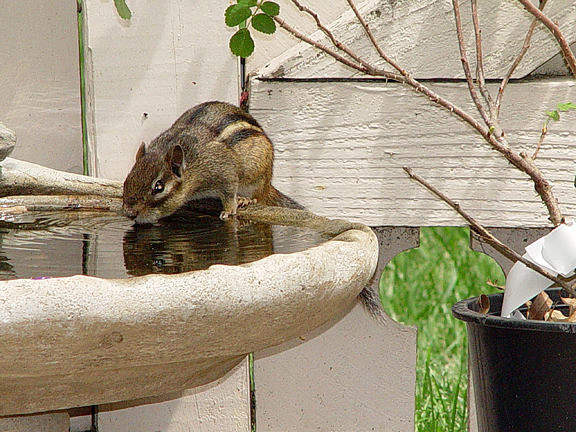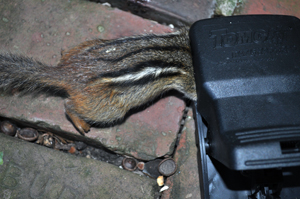Challenging Chipmunks
Return to Agent Articles.  Chipmunks are small reddish brown ground squirrels with striped sides and faces. They are approximately 5 inches in length with a 3 inch hairy tail and weigh about 3 ounces. Chipmunks can have two litters each year with two to seven young. Young are born during April and May and again in August and September. These newborn chipmunks are weaned and on their own in two months and become sexually mature at one year of age.
Chipmunks are small reddish brown ground squirrels with striped sides and faces. They are approximately 5 inches in length with a 3 inch hairy tail and weigh about 3 ounces. Chipmunks can have two litters each year with two to seven young. Young are born during April and May and again in August and September. These newborn chipmunks are weaned and on their own in two months and become sexually mature at one year of age.
Chipmunks live in ground burrows with fairly extensive tunnel systems. The main travel corridor can be up to 30 feet in length with several side chambers used for storing food, bearing young and resting. In many instances these tunnels are adjacent to and under sidewalks, steps, concrete slabs and patios. Unchecked, this tunneling can lead to collapse of these structures. These tunnel systems also may accumulate and divert rainwater toward house foundations which can cause additional problems. Chipmunks also become a nuisance when they dig up newly planted flower bulbs, consume pet food, and rob bird feeders of their seed.
Chipmunks are most active in the mornings and evenings and are very visible. Watching the animal’s activity will indicate their travel patterns and den locations.  They are easily trapped with live traps or rat-type snap traps. These traps can be baited with a variety of items including:
They are easily trapped with live traps or rat-type snap traps. These traps can be baited with a variety of items including:
- Bird seed
- Oatmeal
- Peanut butter
- Peanut butter and oatmeal mixed together
- Sunflower seeds
- Raisins
Place the baited traps near den entrances or along travel lanes for best results.
If live trapped, these animals should be moved several miles away in order to avoid their return.
For more detailed information on chipmunks and their control, contact the Extension office and request the publication entitled Chipmunks: Damage Prevention and Control Methods.
Other Resources